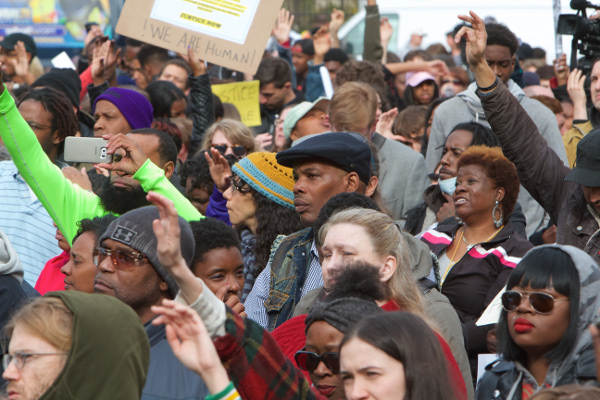
PHOTO/RANDALLART.COM
By Baltimore People’s Tribune correspondents
BALTIMORE, MD — Freddie Gray died on April 19, after being violently subdued, and then subjected to one of the Baltimore Police Department’s infamous “rough rides.” This is where police cuff your hands behind you and do not restrain you with a seat belt. You are then smashed around the metal van interior as the driver slams on the brakes and makes sharp turns.
Baltimore City recently paid $200,000 to the family of a man beaten to death by Baltimore City Police in 2012. In recent years, Baltimore City paid over $6 million to people beaten by police. One hundred nine people died in encounters with Maryland police from 2010 to 2014.
The Freddie Gray case is different only because many people witnessed and recorded his arrest. You could hear him pleading for medical assistance as he was cuffed and thrown into a police van. Forty-five minutes later he was unconscious with a severed spinal cord.
Thousands in Baltimore demonstrated for Justice for Freddie Gray. After the demonstration on Saturday, April 25, spontaneous demonstrations continued around Gilmore St. and the Western Police Station. The Baltimore big four TV stations replaced Saturday night programing with live coverage of the demonstrators downtown. The media and Black city officials constantly shouted out against the “violence” of the demonstrators. Four thousand people marched peacefully but they concentrated on the small percentage who were violent.
Today there are thousands of men, women and youth in Baltimore caught in modern life: they have to work to live and there is no work. The area of Baltimore that used to hold factories, warehouses and shipyards now is home to sports stadiums, hotels, condos, bars, casinos and restaurants.
Once the gentrification began, aggressive policing was begun to protect the “new Baltimore” business property. Baltimore Police rushed to make over 100,000 arrests a year when there are only 625,000 people in the city. This police terror is reaching broader sections of the population. Two weeks before Freddie’s death, Barry Lee Berkenkemper, who is white, died of head and spine injuries in the Aberdeen, MD police station. Christine Abbott, a 27-year old assistant librarian at Johns Hopkins, was given a “rough ride” in 2012 and sustained major physical damage. She was arrested when she asked police and her guests to quit arguing in her home. Arresting officers tore her dress off, exposing her breasts, handcuffed her and threw her into the van. All charges were dropped against her.
Those who want Justice for Freddie Gray are learning several lessons. We need an organization that will represent us. The Democratic Party controls the Maryland legislature and refused to discuss 17 bills to control illegal police action in this year’s assembly. It is not just Black men who are being attacked. They are the first, but women, disabled, Hispanics and whites are receiving Baltimore police clubs and bullets. Finally, we must find a way to distribute society’s wealth equally.How can a person live if there are no jobs? Real leadership must answer these questions and represent all people. The fight for Justice for Freddie Gray is just beginning. We are all Freddie Gray.
